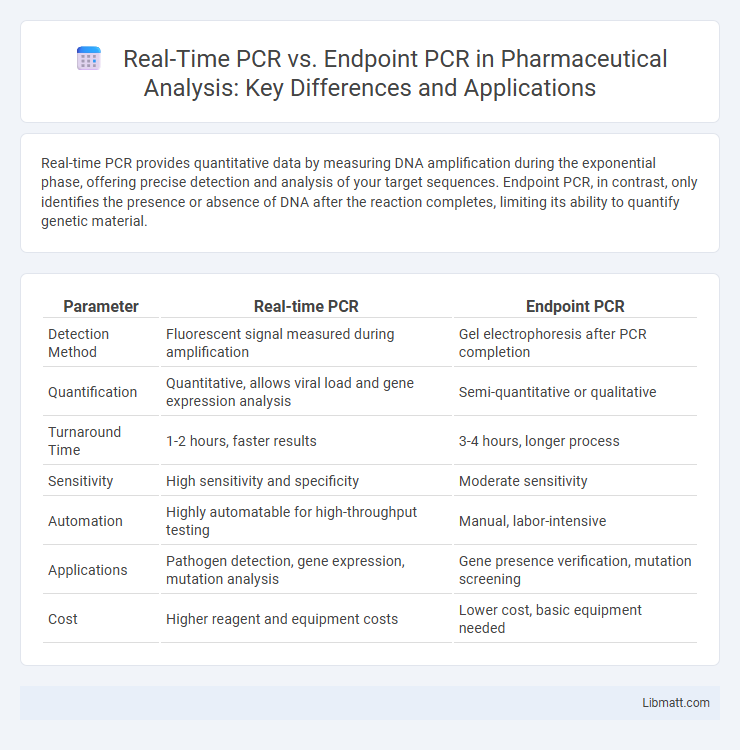Real-time PCR provides quantitative data by measuring DNA amplification during the exponential phase, offering precise detection and analysis of your target sequences. Endpoint PCR, in contrast, only identifies the presence or absence of DNA after the reaction completes, limiting its ability to quantify genetic material.
Table of Comparison
| Parameter | Real-time PCR | Endpoint PCR |
|---|---|---|
| Detection Method | Fluorescent signal measured during amplification | Gel electrophoresis after PCR completion |
| Quantification | Quantitative, allows viral load and gene expression analysis | Semi-quantitative or qualitative |
| Turnaround Time | 1-2 hours, faster results | 3-4 hours, longer process |
| Sensitivity | High sensitivity and specificity | Moderate sensitivity |
| Automation | Highly automatable for high-throughput testing | Manual, labor-intensive |
| Applications | Pathogen detection, gene expression, mutation analysis | Gene presence verification, mutation screening |
| Cost | Higher reagent and equipment costs | Lower cost, basic equipment needed |
Introduction to PCR Techniques
Real-time PCR, also known as quantitative PCR (qPCR), allows for the monitoring of DNA amplification during each cycle, providing quantitative data in real-time, whereas endpoint PCR only measures DNA at the end of the amplification process. Real-time PCR utilizes fluorescent dyes or probes to detect and quantify nucleic acids with high sensitivity, making it ideal for gene expression analysis and pathogen detection. Your choice between these PCR techniques should depend on whether you need precise quantification or a simple presence/absence result.
What is Real-Time PCR?
Real-Time PCR, also known as quantitative PCR (qPCR), amplifies DNA while simultaneously quantifying the amount of target nucleic acid in real time using fluorescent dyes or probes. This technique provides precise, dynamic measurement during the PCR amplification process, allowing for accurate quantification of gene expression, viral load, or genetic variation. Real-Time PCR offers greater sensitivity and faster results compared to traditional endpoint PCR, which only analyzes DNA at the conclusion of amplification.
What is Endpoint PCR?
Endpoint PCR, also known as conventional PCR, is a technique used to amplify DNA by cycling through denaturation, annealing, and extension phases, with analysis performed after the final cycle. This method detects amplified products at the end of the reaction using gel electrophoresis or other visualization techniques, providing qualitative or semi-quantitative results. Endpoint PCR does not measure accumulation of DNA in real-time, limiting its sensitivity and making it less suitable for precise quantification compared to Real-time PCR.
Principle and Workflow Comparison
Real-time PCR quantifies DNA amplification during each cycle using fluorescent markers, enabling precise measurement of initial nucleic acid amounts, whereas endpoint PCR identifies DNA presence only after the completion of all cycles by gel electrophoresis analysis. The real-time PCR workflow includes sample preparation, thermal cycling with continuous fluorescence detection, and quantitative data analysis, contrasting with endpoint PCR's process of amplification followed by post-PCR product visualization. This distinction in principle and workflow allows real-time PCR to provide faster, more accurate, and quantitative results compared to the qualitative endpoint PCR method.
Sensitivity and Specificity Differences
Real-time PCR offers heightened sensitivity by detecting and quantifying DNA during the amplification process, allowing for earlier and more accurate detection of low-abundance targets compared to endpoint PCR. Specificity in real-time PCR is enhanced through the use of fluorescent probes or intercalating dyes that monitor product formation in real time, reducing false positives related to nonspecific amplification prevalent in endpoint PCR. These differences make real-time PCR the preferred method for precise quantification and reliable detection in diagnostic and research applications.
Quantification: Real-Time vs Endpoint PCR
Real-time PCR enables precise quantification of DNA by measuring fluorescence signals during each amplification cycle, providing continuous data for accurate quantitation. Endpoint PCR detects DNA only after all cycles are completed, making quantification less reliable due to plateau effects and variability. Consequently, real-time PCR is preferred for quantitative applications, while endpoint PCR is suited mainly for qualitative analysis.
Applications in Research and Diagnostics
Real-time PCR offers quantitative data useful for gene expression analysis, pathogen detection, and mutation quantification, enhancing diagnostic precision and monitoring disease progression. Endpoint PCR is primarily applied in genotyping, cloning, and detecting presence or absence of genetic material in research, where qualitative results suffice. Real-time PCR's rapid and sensitive detection capabilities make it preferable for clinical diagnostics, while endpoint PCR remains valuable for standard molecular biology protocols.
Advantages of Real-Time PCR
Real-Time PCR offers higher sensitivity and specificity compared to endpoint PCR, enabling the quantification of nucleic acids during the amplification process rather than only at its conclusion. This technique provides faster results with reduced contamination risk due to its closed-tube format, enhancing accuracy and reproducibility. Your ability to monitor amplification in real time allows for precise quantification, making it ideal for diagnostic, research, and forensic applications.
Limitations of Endpoint PCR
Endpoint PCR suffers from limited quantitative accuracy due to detection occurring only after all cycles are completed, making it difficult to measure initial DNA amounts precisely. It is prone to plateau effects where amplification efficiency drops, leading to inconsistent and non-linear results. Additionally, endpoint PCR cannot monitor amplification kinetics in real-time, restricting its use in applications requiring dynamic detection and quantification of nucleic acids.
Choosing the Right PCR Method
Real-time PCR offers quantitative data by measuring DNA amplification during each cycle, making it ideal for applications requiring precise gene expression analysis or pathogen detection. Endpoint PCR provides qualitative results by analyzing DNA only after the final cycle, suitable for applications like genotyping or simple presence/absence tests. Selecting the right PCR method depends on whether real-time monitoring or post-amplification analysis best suits the experimental goals and sensitivity requirements.
Real-time PCR vs endpoint PCR Infographic

 libmatt.com
libmatt.com